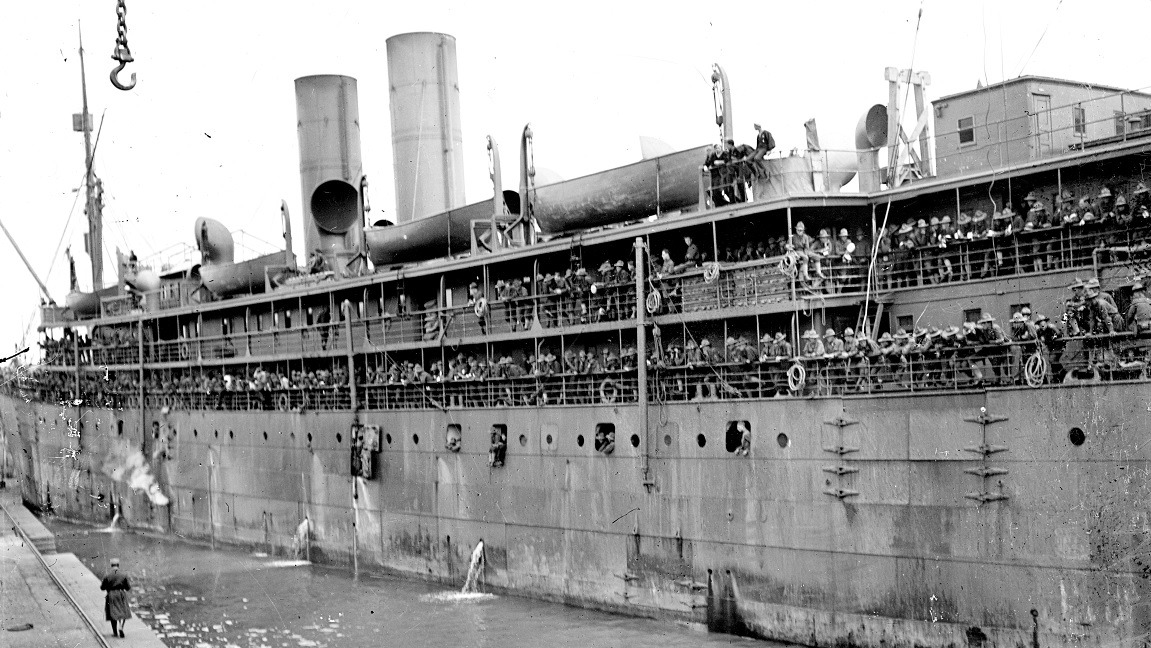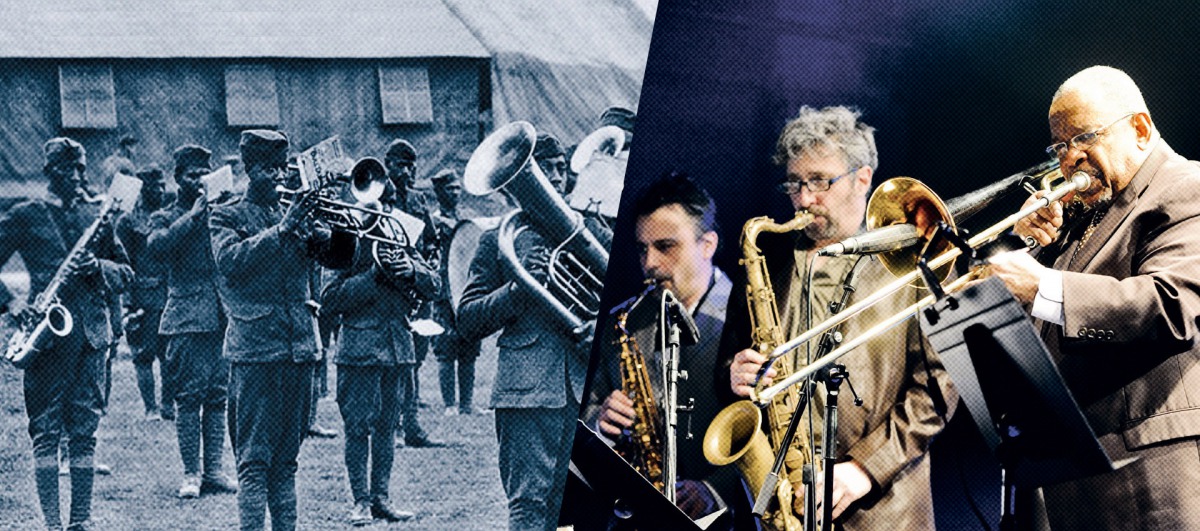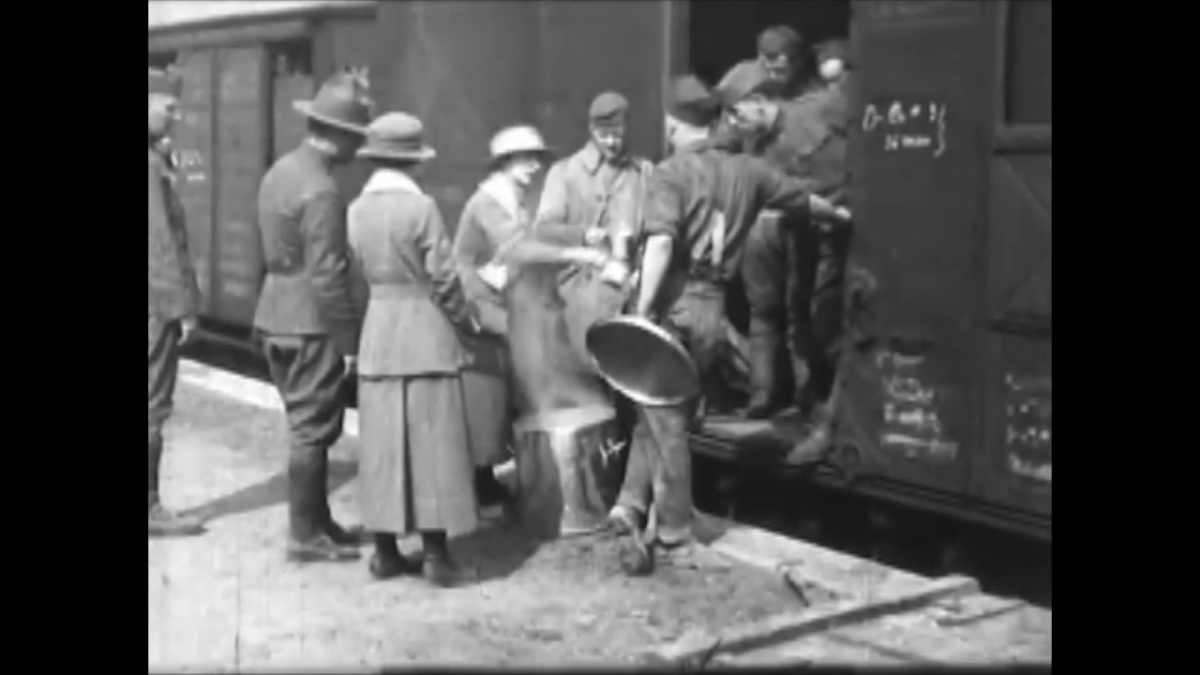The Centennial
The history
THE CENTENNIAL AT THE HEART OF THE BRIDGE
The First World War forever sealed a strong friendship between France and the United States. The American culture brought by the soldiers has been assimilated by French culture and remains ever present today. By mixing music and sport, jazz and basketball, THE BRIDGE 2017 focuses on the legacy of the centennial of the American landing and places this major fact of the Great War at the heart of its festivities.
THE BRIDGE project is certified by the Centennial Mission and the World War I Centennial Commission. It will be one of the major events of the 2017 Franco-American commemoration.
« The year 2017 is a major commemorative moment for the Atlantic seaboard. Several major ports are already preparing for the centennial of the participation of the United States of America in the First World War and the arrival of American troops. THE BRIDGE event is part of this dynamic and will be the highlight of the 2017 commemorative season. The crossing of the Queen Mary 2 from Saint-Nazaire to New York in June will be a strong symbol of the support our American Allies gave 100 years ago. The Bridge is an exhilarating adventure, popular, erudite and essential. Raising the curtain of this great Franco-American season in memory of the 1917 American landing, is very exciting! » Joseph ZIMET, Director General of the Centennial Mission.
THE BRIDGE curtain raiser to a great Franco-American season
The Bridge 2017 celebrates 100 years of Franco-American friendship, vibrating to the rhythm of jazz and basketball, symbols of the influence of US culture on the old continent. American music lovers will find happiness in an eclectic, vibrant diverse program. Sports enthusiasts will not be outdone: the fourth 3x3 Basketball World Cup, hosted for the first time in France, will be held from June 17 to June 21, 2017 in Nantes, as part of this historic and unusual event.

THE 1917 AMERICAN LANDING
On June 14, 1917, 200,000 American soldiers set sail from New York on course for the old continent to defend freedom alongside the Allies. On June 26, 1917, the first infantry division “The Big Red One” landed at Saint-Nazaire, soon followed by two million men. The entry of the United States into the war tipped the outcome of the conflict, sealing the Franco-American friendship.
Saint-Nazaire, the morning of June 26, 1917: the first American contingents landed in France. It is official, the United States has just entered the war, taking sides with allied troops in what will be one of the deadliest conflicts in history, causing nearly 18 million direct military and civilian deaths. The city of Saint-Nazaire was chosen as base number 1: in the space of three years, more than 198,000 men circulated there. The presence of the Sammies could not go unnoticed: soon, 30,000 Americans were cohabiting daily with 35,000 Nazarenes.
The entry of the United States into the war
In 1917, after numerous land and air confrontations, the German government proclaimed the British territorial waters, “a war zone” sounding the beginning of all-out submarine warfare. The latter provoked the entry of the initially neutral United States, into the European conflict. On April 6, 1917, the US Congress voted to recognize the state of war between the United States and Germany.
The United States engaged in the war to uphold the rules of international law, but it did not have the means to do so. At the time, the population was 103 million. They only had a professional army with reduced manpower of barely 200,000 men, whose combat experience was quite limited. The US Congress counted on volunteers to increase its strength and thus managed to build a force of 1.2 million men.
Starting on June 26, 1917, the first American troops landed at Saint-Nazaire, transported by various ships that have become famous, such as the Havana, the Saratoga, the Neptune and the Seattle. Their arrival took place in the presence of the head of the mission, Colonel Stanley, as well as General Silver, in charge of the expeditionary corps, Major Appleton, General Pershing and General Peltier.
The arrival of American soldiers in France
The Americans built camps, harbors and railway stations in France to bring over more than two million soldiers, tons of equipment, munitions, arms and supplies of every kind in less than 18 months. At Bassens, the Americans created an artificial port capable of receiving and unloading twenty ships at a time; next to Saint-Nazaire, in Bois-Joalland, they created an artificial lake of more than one and a half million cubic meters to obtain drinking water. The entry of the United States into the war was a new lease of life for the parties of the alliance. It is associated not only with the arrival of many soldiers but also with military equipment, new strategies, and products and customs hitherto unknown. The American soldiers brought with them a whole panoply of what makes the New World unique. They gave French civilians soap, chocolate, chewing gum (a discovery for the French), mild tobacco cigarettes and even tin cans. The French population discovered American culture via jazz, blues, and basketball.
The Armistice and Franco-American friendship
After the failure of the German offensives in the spring of 1918, the Allies managed to regain the advantage in the summer. The victorious offensive took place on August 8, 1918. The Canadian, Australian, French and British troops launched an attack in Picardy and penetrated the German lines. As early as September 1918, in the east, the American and French soldiers also launched the offensive in Meuse-Argonne. Thousands of German soldiers surrendered without fighting. German society was then exsanguinated: revolutionary troubles erupted as the army retreated and the number of prisoners increased. After the abdication of William II, on November 9, 1918, the armistice was officially signed on November 11, 1918, thus putting an end to four terrible years of war.
THE AMERICAN CULTURAL HERITAGE
By setting foot on hexagonal (French) ground, the American soldiers did not bring their dreams of peace with them. They came with their culture and an unshakeable desire to share it. France then discovered many products hitherto unknown, leisure, music tunes and a certain vision of sport. Thus, basketball landed and the first jazz notes rang out... A current which, after France, quickly irrigated the whole Old Continent.
« Overall, two million men have passed through the ports of the North Sea and the Atlantic, it is considerable. This influx into the ports of Boulogne-sur-Mer, Saint-Nazaire and Brest also left a considerable logistic and social imprint. I do not think we are sufficiently aware of the impact of the landing in this “Middle War” – because there is a tendency to focus on older links, namely those of La Fayette, and D-Day. The Americans, because of the magnitude of their presence in our ports, left more footprints and a social heritage perhaps even stronger than that during the Second World War. The arrival of these millions of soldiers from across the Atlantic, bringing with them jazz, new sports, as well as profound modifications of landscapes and infrastructures, provoked an immense social and cultural upheaval. » Joseph ZIMET, Director General of the Centennial Mission.
Jazz
From 1915, jazz has permeated American culture profoundly. To maintain the morale of the troops, James Reese Europe headed the orchestra of the 369th US Army Infantry Regiment. It arrived in France on January first, 1918, the orchestra played a Marseillaise at a frenetic pace which was as much disconcerting as it was exciting. The orchestra eventually played in the biggest cities of France, spreading this new movement called “Jazz”.
Little by little, jazz seduced: the “78s” and the dance halls constantly broadcasted the new melodies that lightened minds and hearts. Famous American jazzmen remained in France, and some, such as Sidney Bechet and Kenny Clarke even lived there, shaping the artistic landscape of twentieth-century France.
Basketball
The emblematic sport of North American culture, basketball quickly spread to Europe until it became an official event of the Summer Olympics in 1936. A few years later, in 1950, this sport was the focus of all attention and we witnessed the world basketball championship for the first time. Wheelchair basketball, known as “chair basketball”, has also established itself as an activity for former World War II soldiers: an excellent exercise to rehabilitate the wounded and help them regain their morale.

EVENTS ON LAND AND SEA
A private initiative devised by the organizer and offshore racer Damien Grimont and chaired by Patrick Boissier and Francis Vallat, THE BRIDGE 2017 project is primarily a unique and historic race between the Queen Mary 2, the most prestigious transatlantic “liner”, and the ultimate trimarans, the fastest multihulls in the world. An unprecedented challenge between Saint-Nazaire and New York, in the wake of the 1917 American landing...
The 2017 centennial is characterized by the sea: a series of events will not only pay tribute to the arrival of the first American troops, but also to submarine warfare, and to the technical innovations arising from these maritime conflicts, in particular the camouflaging of ships. The centennial Armada that will accompany the Queen Mary 2 will be a highlight.
A memorable departure from Saint-Nazaire
Before the grand departure, the cruise liner will sail from Southampton on the evening of June 22, stop at Cherbourg on June 23 to board its passengers and travel onto the port of Saint-Nazaire on June 24, escorted by an armada of foreign navies from Brest.
The arrival of the Queen Mary 2 in the Loire estuary will be part of a weekend of centennial celebrations: a commemorative ceremony will pay tribute to the arrival of the first American contingents, in particular The First Division; the port will be pedestrianized to allow visitors to admire the cruise ship and to attend a popular banquet and air show. The evening will end with a pyrotechnic spectacle.
At the same time, the maxi-trimarans departing from Nantes will have arrived in the Loire estuary to reach Saint-Nazaire, where three cannon shots will signal the start of the centennial Transat.
A cultural program on board
On Sunday, June 25, the Queen Mary 2 will begin its crossing to arrive on July first in New York. The World War I centennial mission, which has hallmarked this project, will participate in the implementation of a rich and packed cultural program on the cruise ship, celebrating 100 years of Franco-American friendship across the Atlantic.
At the heart of the “liner”, in the central rotunda and the largest restaurant, a monumental exhibition will showcase the US entry into the war and its cultural contributions, from jazz to American sports such as baseball, boxing and basketball. Many archival images from the ECPAD (Etablissement de Communication et de Production Audiovisuelle de la Défense [Defense Communication and Production Establishment]) will feed this accessible and didactic exhibition.
During the crossing, the republican guard will be the guest of honor and perform a series of concerts on board; a “Centennial Cinema Club” will bring together unpublished documentaries on the entry of the Americans into the war, including the one by the American Hospital in Paris, which recounts the role of the American volunteers as early as 1914, and that of the CC&C production house, The Americans in the Great War. Finally, many specialists of the First World War and transatlantic relations will host historical conferences.
A symbolic arrival in New York
One hundred years after the 1917 landing, the Queen Mary 2 will have made the crossing back to the United States, from the bridge of Saint-Nazaire to the Verrazano-Narrows bridge. On the early morning of July first, the ship will salute the Statue of Liberty, a gift from France to the Americans, by saying in turn “thank you” for the participation of the Sammies in the war effort. A strong symbol, as a sign of a hundred years of Franco-American friendship.
An Armada of foreign navies escorts the Queen Mary 2
The French Navy joins forces with the commemorations: from June 21, 2017, the harbor of Brest will host an armada of foreign navies made up of a dozen vessels. Among the invited countries, the United States, the United Kingdom, Canada, Brazil and Germany have already responded. The centennial armada will escort the prestigious Cunard liner to Saint-Nazaire, the departure city of the centennial Transat..
From June 21 to June 24, 2017, a series of events will punctuate the festival of music and the centennial of the arrival of the American troops in Brest, with notably a commemorative ceremony on June 22 near the American monument of the Cours d’Ajot.
On June 24, the entire fleet will form a naval parade in the harbor of Brest, then join the Queen Mary 2 which will leave the port of Cherbourg the same morning. This escort will form the first bridge between the navy of yesterday and today, between the crossing of 2017 and the one undertaken a hundred years ago by the first Sammies.
The Centennial Armada will accompany the Queen Mary 2 to the entrance of the estuary of the Loire, greeting the spectators from the open sea who will welcome one of the biggest cruise liners in the world.
THE CENTENNIAL MISSION
Established in 2012, the Centennial Mission is a public interest group (PIG) initially composed of seven ministries, six public institutions, two national associations, one university and one cooperative union. This mission was commissioned by the government to prepare and support the implementation of the commemorative program under the direction of Joseph Zimet (Director General) and Laurent Veyssière (Deputy Director-General).
One of the objectives of the Centennial Mission is to organize the major meetings of the memorial calendar, to support and coordinate initiatives developed throughout France and to propose an information policy on the preparations and Centennial program for the benefit of the public. Its board of directors is chaired by General (2S) Elrick Irastorza. It has the expertise of a scientific council and relies on a territorial network of the Centennial Departmental Committees (CDC) and Centennial Academic Committees (CAC).
Joseph ZIMET, Director General of the First World War Centennial Mission, details the commemorative scope of THE BRIDGE and the Centennial Mission’s support for the event:
« 2017 will be a major commemorative year for the Atlantic seaboard. Several key harbours are already preparing for the Centenary of the participation of the United States of America in the First World War and the arrival of American troops; in particular, the cities of Boulogne-sur-Mer, Brest and Saint-Nazaire , where more than 2 million soldiers landed from 1917 onwards.
THE BRIDGE project fits directly into these ambitious plans, and will be the highlight of the 2017 commemorative season. The Queen Mary 2 cruise liner crossing from Saint-Nazaire to New York in June will be a strong symbol of the support given a hundred years ago by the American allies. It was an immense social and cultural upheaval that gave rise to the arrival of these millions of soldiers from across the Atlantic, bringing with them jazz and new sports as well as profound changes to the landscape and infrastructure.
The First World War Centennial Mission, under the patronage of Jean-Yves Le Drian, Minister of Defence, and Jean-Marc Todeschini, Secretary of State for Veterans Affairs and Remembrance,, have been part of this ambitious project since it was first created in 2014. They will participate actively in setting up the rich and full cultural programme on offer to celebrate the 100 years of Franco-American friendship across the Atlantic.
This spectacular and popular event will shine a spotlight on the Centennial celebrations, highlighting the participation of the Atlantic coastal territories in the war effort and the consolidation of a strong Franco-American alliance, a new milestone in our common history, and an extension of the support that the Marquis of La Fayette had brought to American revolutionaries.
The Centennial Mission is proud to accompany this groundbreaking and ambitious project, extending a new bridge, a hundred years later, from France to the United States of America. »
